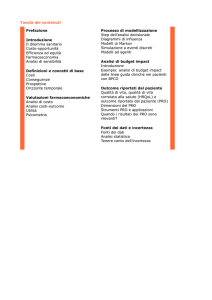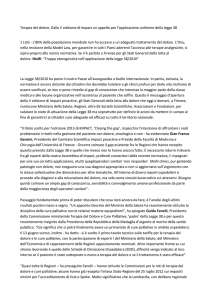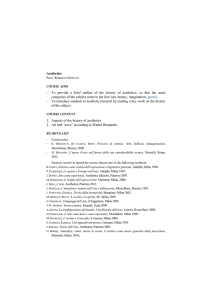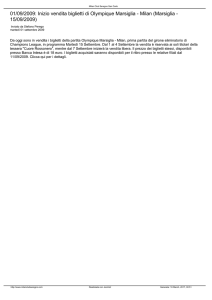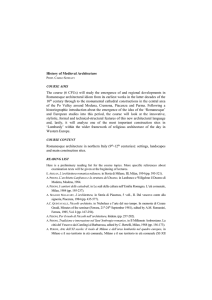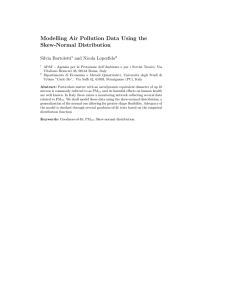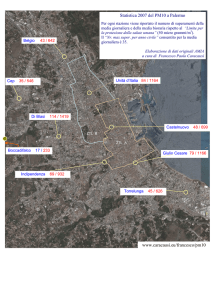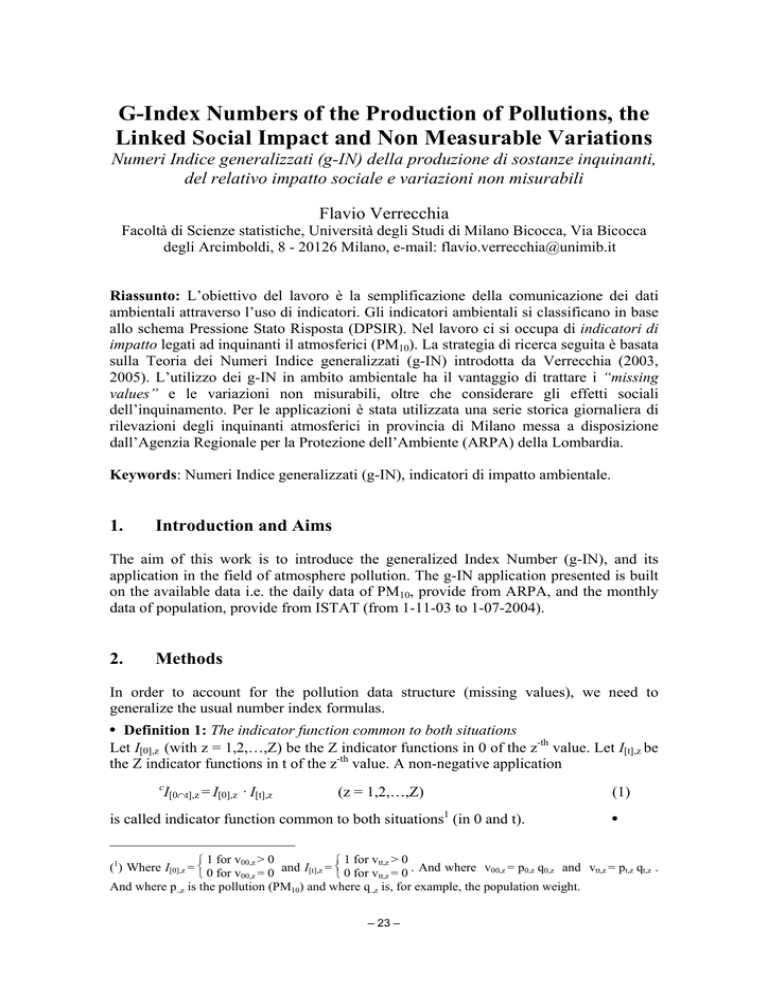
G-Index Numbers of the Production of Pollutions, the
Linked Social Impact and Non Measurable Variations
Numeri Indice generalizzati (g-IN) della produzione di sostanze inquinanti,
del relativo impatto sociale e variazioni non misurabili
Flavio Verrecchia
Facoltà di Scienze statistiche, Università degli Studi di Milano Bicocca, Via Bicocca
degli Arcimboldi, 8 - 20126 Milano, e-mail: [email protected]
Riassunto: L’obiettivo del lavoro è la semplificazione della comunicazione dei dati
ambientali attraverso l’uso di indicatori. Gli indicatori ambientali si classificano in base
allo schema Pressione Stato Risposta (DPSIR). Nel lavoro ci si occupa di indicatori di
impatto legati ad inquinanti il atmosferici (PM10). La strategia di ricerca seguita è basata
sulla Teoria dei Numeri Indice generalizzati (g-IN) introdotta da Verrecchia (2003,
2005). L’utilizzo dei g-IN in ambito ambientale ha il vantaggio di trattare i “missing
values” e le variazioni non misurabili, oltre che considerare gli effetti sociali
dell’inquinamento. Per le applicazioni è stata utilizzata una serie storica giornaliera di
rilevazioni degli inquinanti atmosferici in provincia di Milano messa a disposizione
dall’Agenzia Regionale per la Protezione dell’Ambiente (ARPA) della Lombardia.
Keywords: Numeri Indice generalizzati (g-IN), indicatori di impatto ambientale.
1.
Introduction and Aims
The aim of this work is to introduce the generalized Index Number (g-IN), and its
application in the field of atmosphere pollution. The g-IN application presented is built
on the available data i.e. the daily data of PM10, provide from ARPA, and the monthly
data of population, provide from ISTAT (from 1-11-03 to 1-07-2004).
2.
Methods
In order to account for the pollution data structure (missing values), we need to
generalize the usual number index formulas.
• Definition 1: The indicator function common to both situations
Let I[0],z (with z = 1,2,…,Z) be the Z indicator functions in 0 of the z-th value. Let I[t],z be
the Z indicator functions in t of the z-th value. A non-negative application
c
I[0∩t],z = I[0],z · I[t],z
(z = 1,2,…,Z)
is called indicator function common to both situations1 (in 0 and t).
(1)
•
⎧ 1 for v00,z > 0
⎧ 1 for vtt,z > 0
(1) Where I[0],z = ⎨ 0 for v = 0 and I[t],z = ⎨ 0 for v = 0 . And where v00,z = p0,z q0,z and vtt,z = pt,z qt,z .
⎩
00,z
⎩
tt,z
And where p.,z is the pollution (PM10) and where q.,z is, for example, the population weight.
– 23 –
• Definition 2: The g-Laspeyres aggregative index number formulae
g-L
0Pt
Let RS [l] (with l = 1,2,…,L) be the g-Laspeyres index number2 of the l-th land. Let
c
V00,l be the sum by z of the r<Z values in 0 (where z = 1 , 2, … , r, … , Z) common to
both situations (0 and t) of the l-th land. A non-negative application
L
0Pt
g-L
RS [ ∪Ll] =
∑ RS
0Pt
c
g-L
V00, l
(2)
L
[l]
∑ cV00, l
l=1
l=1
is called aggregative formulae of g-Laspeyres index number.
•
• Definition 3: The g-Paasche aggregative index number formulae (g-Laspeyres
cofactor)
g-P
0Qt
Let RS [l] (with l = 1,2,…,L) be the g-Paasche index number3 of the l-th land. Let cVt0,l
be the sum by z of the r<Z product of pollution in t and population in 0 (where z = 1 , 2,
… , r, … , Z) common to both situations (0 and t) of the l-th land. A non-negative
application
L
0Qt
g-P
RS [ ∪Ll] =
∑ RS
0Qt
c
g-P
Vt0, l
[l]
L
(3)
∑ Vt0, l
c
l=1
l=1
is called aggregative formulae of g-Paasche index number.
•
• Definition 4: The impact index common to both situation
negative application
A non-
c
0Vt
=
0Pt
g-L
RS [∪Ll]
0Qt
g-P
RS [∪Ll]
(4)
is called impact index common4 to both situations.
•
Z
∑ pt,z q0,z cI[0∩t],z I[l],z
g-L
0P t
(2) Where RS [l] =
z=1
Z
and I[l],z is the l-th indicator function of the land.
∑ p0,z q0,z cI[0∩t],z I[l],z
z=1
Z
∑ pt,z qt,z cI[0∩t],z I[l],z
g-P
0Q t
(3) Where RS [l] =
z=1
Z
and I[l],z is the l-th indicator function of the land.
∑ pt,z q0,z cI[0∩t],z I[l],z
z=1
4
( ) The total impact index (0Vt) can be factorized on contribution due to the impact index common to both
– 24 –
3.
Application
The application consist in a Aggregative g-index number system. The impact index
common to both situations factorizations (g-indices) are able to explain variations like
contribution due to pollutions and to population of the impact index (Figure 1.). The
data used, in this first stage, are daily for the PM10 (provide from ARPA), and monthly
from the population (provide from ISTAT). Particularly data from 1-11-03 to 1-07-2004
have been employed. The great Milan impact index have been built from the PM10 and
Population g-index. And both from the sub-g-indices of Milan and Hinterland. By this
application is easy to extend the same methodology to the European area and sub area
without to restart from the data.
Figure 1: Aggregative g-IN system: Milan, Hinterland of Milan, Great Milan
Total Impact
index
Impact index
PM10 index
Population index
Non comparable
effect (B0t)
Source: ARPA Lombardia; ISTAT [On line], available: http://demo.istat.it.
Note 1. Population sub-area is a crude estimation.
situations and to Basket factor (Verrecchia 2003, 2004b, 2005): 0Vt = c0Vt · B0t.
– 25 –
4.
Result and Conclusion
The generalized index number (g-IN) theory provide the impact index common to both
situations and, as its factorizations, g-indices able to explain variations like contribution
due to pollutions and to population. Table 1. shows the index of great Milan that has
been built from Milan g-IN and Hinterland of Milan g-IN. So, from set of sub-area, it is
possible to build g-indices of sub-g-indices, if it is provided the correct weight and,
obviously, the sub-g-indices.
Table 1: Great Milan aggregative g-IN: from Milan g-IN & Hinterland of Milan g-IN
1-7-04/1-11-03
Total Impact index (note 4)
Impact index (expr. 4)
PM10 index (expr. 2) (w=cV00/∑ cV00)
Population index (expr. 3) (w=cVt0/∑ cVt0)
B0t - Non comparable effect (note 4)
MI
1,5895
1,5895
1,5714
1,0115
1,0000
WeightMI
0,4058
0,3857
-
Hinterland MI
2,0904
1,7313
1,7092
1,0129
1,2075
WeightHintMI
0,5942
0,6143
-
Great MI
1,8872
1,6737
1,6533
1,0124
1,1275
Source: ARPA Lombardia; ISTAT [On line], available: http://demo.istat.it.
The methodology is available. There are problems about data quality and data
production to build impact index: the population data are not provided daily, like
pollution one, so daily impact index are not generally calculable without the use of
estimation techniques.
References
ARPA Lombardia (2003), Rapporto sulla Qualità dell’aria di Milano e provincia, ARPA
Lombardia, Milano.
Fisher I. (1922), The making of index numbers: a study of their Varities, Tests, and
Reliability, reprinted by Augustus M. Kelley Publishers, New York.
Martini M. (2001), Numeri indice per il confronto nel tempo e nello spazio, CUSL,
Milano, 79-108.
Pliska S.R.(1997), Introduction to mathematical Finance: discrete time models,
Blackwell Publishers, Oxford.
Verrecchia F., Zavanella B. (2002), Methodological Problems in Index Numbers’
Construction For Multi-Temporal Comparison in the Financial Field, in: Atti della
XLI Riunione Scientifica SIS, CLUEP, Padova. 529-532.
Verrecchia F. (2003), Index numbers system for spatial and time comparison applied to
finance, in: Atti del Convegno Intermedio SIS, Napoli.
Verrecchia F. (2004a), Aggregative Index Numbers Minimal System, in: Atti XLII
Riunione Scientifica SIS, CLUEP, Padova.
Verrecchia F. (2004b), Generalizzazione delle tradizionali formulae della teoria dei
numeri indice: Laspeyres, Paasche, Fisher generalizzati, Congiuntura, 4, Udine.
Verrecchia F. (2005), Théorie des nombres index: les Nombres Index généralisés (gIN), in: acte des JMS ‘05 de l’INSEE, Paris, [On line]. Available: http://jms.insee.fr.
Williams D. (1991), Probability with Martingales, Cambridge University press,
Cambridge.
– 26 –

